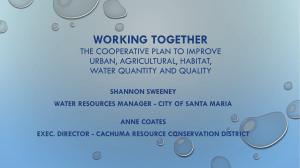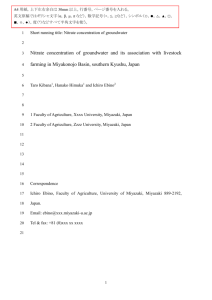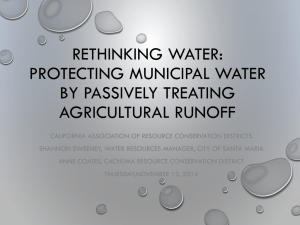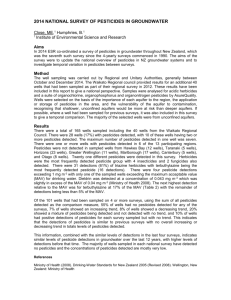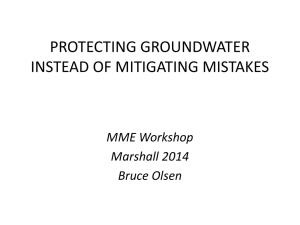Pesticides & Risk - Minnesota Senate
advertisement
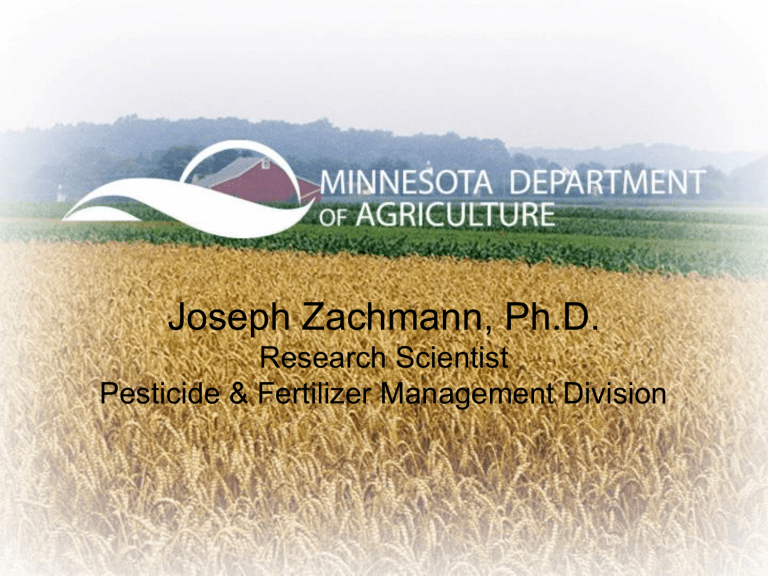
Joseph Zachmann, Ph.D. Research Scientist Pesticide & Fertilizer Management Division Pesticides & Risk Pesticides control insect pests, weeds and diseases and may pose risk to human health and the environment Some pesticides leach to groundwater People are concerned about exposure risks Are there pesticides in my drinking water? How high are the concentrations relative to known risk? Even if concentrations are low, what about unknown risks like exposure to pesticides in mixtures, endocrine disruption and other concerns? Groundwater Monitoring for Pesticides MDA monitoring networks are designed for agricultural pesticides Central Sand Plain monitoring well nest Wells are located adjacent to operating farm fields Far from non-agricultural contaminant sources; intersect water table to represent worst-case scenario Southeast karst bedrock aquifers are monitored via springs Extremely rare long-term data set – entering 29th year Statewide Network What are we looking for? In 2011 276 groundwater samples From 171 wells/sites CWF helped purchase state-ofthe-art LC/MS-MS equipment to: Find pesticides at lower concentrations Increase number of pesticides & samples analyzed Each sample analyzed for 110 different pesticides or degradates = 30,000 analyses annually As new pesticides are registered they are reviewed for risk and may be added to the analytical list What do we find? • 40 pesticides or degradates detected • Most are found in fewer than 4% of samples • Commonly detected in vulnerable areas: Acetochlor Alachlor Atrazine Metolachlor Metribuzin • No pesticide concentrations exceeded MDH drinking water risk levels Metolachlor in Central Sands Atrazine and its Degradates in Central Sands • Atrazine and its degradates are frequently detected, but concentrations have decreased significantly in recent years • Atrazine and degradate concentrations: 2000-2012 Atrazine in Southeast Karst 0 .3 A tr a z in e + D e is o p r o p y la tr a z in e + D e s e th y la tr a z in e 0 .2 0 .1 100 2 1 1 0 P M R 9 80 A ll s p r in g s 60 40 20 A tr a z in e D e s e t h y la tr a z in e D e is o p r o p y la tr a z in e 2 2 0 1 1 2 0 1 0 2 0 2 Y ear 1 0 9 0 8 0 2 0 2 0 7 0 6 2 0 0 5 0 2 0 0 0 4 0 2 F r e q u e n c y o f D e te c tio n (% ) 2 2 0 1 0 2 0 1 9 2 0 0 8 2 0 0 0 2 Y ear 0 7 6 2 0 0 0 2 0 2 0 5 4 0 3 0 2 0 2 0 2 0 1 0 0 2 0 0 0 N D 2 C o n c e n tr a tio n ( p p b ) D N R F is h H a tc h e r y S p r in g s M e d ia n Uncertainties and Groundwater Risks • Possible changes in pesticide use patterns & groundwater impacts due to: – – – – New pesticide-resistant crop technologies Weed resistance to current pesticides Invasive species control Climate change effects (warming) on economic crop pests – Climate change effects on increased precipitation intensity and greater leaching and runoff All MDA monitoring data is: • Reviewed, compiled and reported annually • Submitted to MDH, MPCA and EPA for evaluation • Available and stored long-term in MPCA’s EQuIS database QUESTIONS? Joseph Zachmann, Ph.D. Research Scientist Pesticide Management Unit Minnesota Department of Agriculture 651-201-6588 joseph.zachmann@state.mn.us Nitrates in Groundwater within Agricultural Regions of Minnesota Senate Legislative Briefing: Environment and Energy Committee April 9, 2013 Bruce Montgomery Section Manager Fertilizer Non-Point Section Pesticide and Fertilizer Management Division MN Department of Agriculture A groundwater/drinking water contaminate of major concern Nitrate NO3-N Why the Concerns? Why the Concerns? Nitrate Loading to Groundwater Can Be Significant In Sensitive Geologic Areas PARK RAPIDS WELL 4 14 12 Nitrate-N (mg/L) 10 8 6 4 y = 0,0012x - 40,114 R² = 0,688 2 0 Jan-93 1993 Oct-95 1998 Jul-98 2003 Apr-01 Jan-04 2008 Oct-06 These Areas Tend to Be Very Localized Jul-09 The Many Escape Routes of Nitrogen Nitrate movement to groundwater, springs, and tile drainage waters can be appreciable Potentially Lost to Groundwater, Surface Water or Tile Drainage Groundwater Stressors What’s Grown on the Land Strongly Influences Nitrate Loss to the Aquifer Cropping Systems are NOT created equal Crops with Low N Loss Leaching Potential Alfalfa and Clover Native Prairie/CRP Plantings Vegetated Pasture Perennial Crops The Last 90 Years….. Acreage Trends in Minnesota’s “Legume” Crops (All Hay and Soybeans) 8 7 Millions of Acres 6 Alfalfa, Soybean Clover, etc Soybeans Hay 5 4 3 2 1 0 1921 1931 1941 1951 1961 1971 1981 1991 2001 2011 Year The Last 90 Years….. Acreage Trends for Minnesota’s Major Nitrogen Demanding Crops All Small Grain Crops Millions of Acres 10 Corn 8 Corn 6 Small Grains Potatoes Sugarbeet Sunflower 4 Edible Beans 2 0 1920 1930 1940 1950 1960 1970 Year 1980 1990 2000 2010 Crops with High N Loss Leaching Potential Grain Corn Potatoes Silage Corn Edible Beans Commercial Nitrogen Fertilizer Sales Trends in U.S.& Minnesota: 1965-2011 Data Source: MDA, TVA, and AAPFCO 900,000 14,000,000 800,000 12,000,000 10,000,000 600,000 8,000,000 500,000 400,000 6,000,000 MN Sales (left axis) 300,000 200,000 4,000,000 US Sales (right axis) 2,000,000 100,000 0 1960’s 1970’s 1980’s 1990’s 2000’s 0 2010’s Tons of N Sold in the U.S. Tons of N Sold in Minnesota 700,000 Ratio of Bushels Produced per Lb N Fertilizer Input MN Farmers Continue to Increase Efficiency from Their Nutrient Inputs 1.4 Statewide "NUE" on Corn Using the N Balance Method 1.2 1.0 0.8 0.6 0.4 Bushels of Corn Produced per Lb of N Fertilizer 1992 to 2011 County Well Index Data Nitrates in Private Drinking Wells Most elevated conditions are found in the Central Sands region and Washington/Dakota Counties; (Note that only wells with nitrate-N > than 3 mg/L are illustrated here) Two “Home Owner” Nitrate Monitoring Networks have been Recently Established • Networks have been designed to provide lowcost nitrate trend information; • Private wells selected on a pre-determined grid; • Multi-Agency support; • SWCD and/or Local Environmental Health shoulder much of work Homeowner Participation is the Cornerstone of the Design Nitrates in Private Drinking Wells in the Central Sands • Home Owner Network Approach included 1,555 Minnesota families; • This recent data (2011) suggests that about 5% > Health Standard (10 mg/L); • Approx. 500-600 wells will be used for long-term trends This Type of Information will be Extremely Valuable to Future Generations Southeast Nitrate Monitoring Network 2008 to 2011 % Over 10 mg/L 16 14 12 10 8 6 4 2 0 Feb'08 Aug'08 Feb'09 Aug'09 Data Source: MDH Aug'10 Aug'11 Recent Analysis Suggests that between 200-300 Agricultural Townships Are at Potential Risk (based upon GIS layering of sensitive surficial geology and row crop density) Nitrates in Public Water Supplies Nitrates in Public Water Supplies Based upon MDH data, less that 1% of Minnesota’s public water supplies exceed the MCL; (Note that only wells with nitrate-N > than 3 mg/L are illustrated here) Figure 10. Distribution of public water supply wells in the County Well Index with nitrate-N greater than 3 mg/L Data Source: MDH Roughly 20-25 Public Water Suppliers in Agricultural Areas are Dealing with Nitrate Issues Rapidly Increasing Nitrate Levels Are Not Uncommon in These Highly Sensitive Landscapes PARK RAPIDS WELL 4 14 12 Nitrate-N (mg/L) 10 8 6 4 y = 0,0012x - 40,114 R² = 0,688 2 0 Jan-93 1993 Oct-95 1998 Jul-98 2003 Apr-01 Jan-04 2008 Oct-06 Jul-09 What’s at Stake for Community Water Suppliers Dealing with Nitrate Problems? • Nitrate removal systems typically cost more than $3 Million for upfront construction costs and also maintenance costs • Costs of drilling new and/or deeper wells; • Costs of ‘blending” multiple wells to achieve get acceptable water quality; • Consumer costs are 2-6 times higher than non-impacted water supplies LESSONS LEARNED: MDA, MDH, and our partners have tools and case studies to share http://www.mda.state.mn.us/protecting/waterprotection/drinkingwater.aspx



